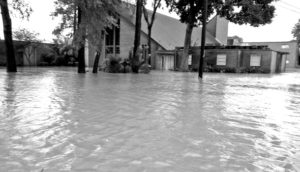
Heroes of Harvey: Restoring Resurrection
Houston’s largest LGBTQ church is forced to rebuild—again—after Harvey.
By Marene Gustin
Debbie Holmes has been a member of Houston’s Resurrection Metropolitan Community Church, which ministers to LGBTQ people and their families and friends, for 33 years.
With more than 400 members, Resurrection is the fourth-largest MCC congregation in the world, according to Pastor Troy Treash. Situated on West 11th Street along White Oak Bayou in the Heights, the church sustained major flooding during Tropical Storm Harvey.
And it wasn’t the first time. “I think it was worse during [Tropical Storm] Allison,” Holmes says, recalling the previous flood in 2001. “We only got about a foot-and-a-half of water in the sanctuary this time.”
 Resurrection MCC, begun in the early 1970s as an inclusive, equality-based house of worship, has had four locations in its history. In 2000, as members outgrew their third space, the church moved to the beautiful nine-acre campus it currently calls home. Today, the church shares its space with 25 other community organizations, from Pride Charities and the Gay Men’s Chorus to a local Narcotics Anonymous group.
Resurrection MCC, begun in the early 1970s as an inclusive, equality-based house of worship, has had four locations in its history. In 2000, as members outgrew their third space, the church moved to the beautiful nine-acre campus it currently calls home. Today, the church shares its space with 25 other community organizations, from Pride Charities and the Gay Men’s Chorus to a local Narcotics Anonymous group.
The church’s senior pastor, Rev. Troy Treash, wasn’t at Resurrection during Tropical Storm Allison. Treash was with Bering Memorial United Methodist Church in Montrose at the time. “We [at Bering] just had our basement flooded,” Treash recalls. “So I was able to come over here to help out. [Resurrection] lost all of their pews in that flood.”
This time, thanks to hundreds of volunteers like Holmes, the pews were removed, cleaned, and stored in the choir loft after the storm hit. “That was the hardest part,” Holmes says. “But we had to do it to get the wet carpet up. We’re just lucky we could save the pews this time.” Holmes spent the better part of the week after Harvey volunteering at the church.

“People brought in breakfast and lunch for us,” she says. “People would see our cars in the parking lot and stop and ask if we needed help. One guy stopped and thought we were opening a shelter, but when we showed him the water damage, he just jumped in and started pulling sheetrock. He was amazing.”
Thanks to parishioners, neighbors, University of Houston students, and complete strangers, it wasn’t long before all of the ruined sheetrock and carpet was pulled.
“They are like a second community center, and by far they were the worst-hit [organization] in the queer community,” says Kent Loftin, development director at the Montrose Center, which dispatched volunteers and food to the church in the wake of Harvey. “We need them in the community.”
In addition to dealing with damage to church property, Resurrection MCC was busy assisting members who experienced flooding at their homes. “Since the hurricane, we learned of 31 of our families who needed support,” Treash wrote in an email to members on September 15. “You quickly responded and have met many of those needs.
“Some of our Resurrection family are now living with friends or have found temporary housing,” he added. “Others have relocated to a second floor in their house. Many are experiencing the space between the immediate activity of tearing out and waiting to start repairing and replacing.”
Fortunately, unlike many churches, Resurrection MCC had some flood insurance. “But our elevator is out, and if you remember after Allison, you could get contractors, but it was hard to find any sheetrock,” Treash says. “I just pray we can get back in the sanctuary before Christmas.”
By September 2, the church was able to set up folding chairs in the one building that didn’t flood, their gym, and hold worship services. “The reverend asked everyone to stand up who had helped out with the cleanup, and half the congregation stood up,” Holmes says.
“We ended the service with the gospel song ‘Standin,’” Treash says. “One of the lines is, ‘When the storm is over, I’ll be standing.’ So it was very appropriate.”
But how many times can they rebuild? As with many others who own homes and businesses near the city’s multiple bayous, the question on the minds of church leaders is a tough one: rebuild or relocate? “Boy, we’ve wrestled with that since the last flood,” Treash says. “We’ve been praying and talking about it since Tropical Storm Allison.”
By mid-September, the church had convened a small design team, and was consulting with experts and procuring bids. “We will continue to make choices that consider the impact of future flooding in Houston—whether in 15 years or 50 years,” Treash wrote to members.
In addition to flooding concerns, Treash says the foundation of the church’s gym is settling oddly. “As it turns out, the bayou once looped around under the ground there before the engineers straightened it out,” he says. “I think it wants to go back to the way it was.”
Many, like Holmes, are opposed to the idea of moving the church. “I don’t want to do that,” she says. “This is a great area, centrally located, and we have members come from all over. This is the perfect spot.”
“We are attached to that space,” Treash adds. “It really is beautiful—except when it floods.”
You can donate to the church’s rebuilding efforts at resurrectionmcc.org.
This article appears in the October 2017 edition of OutSmart Magazine.











Comments